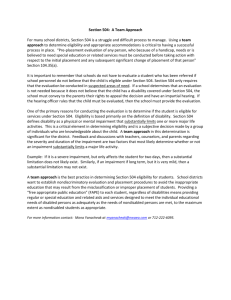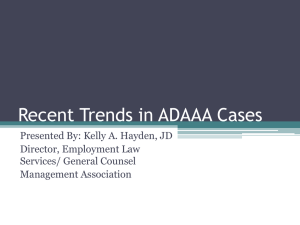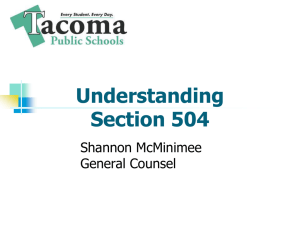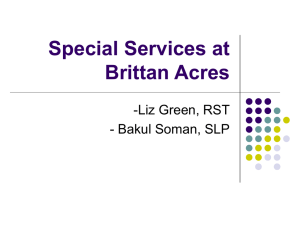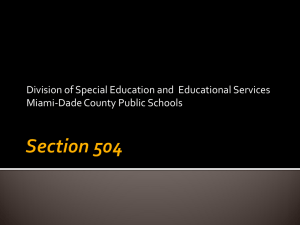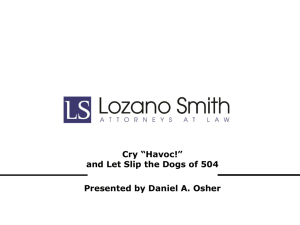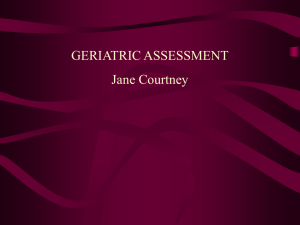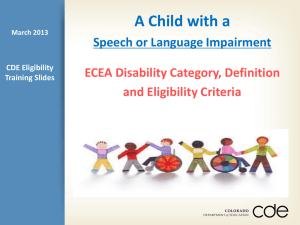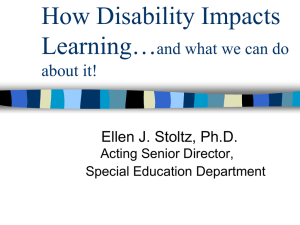Section 504 - Washington School Counselor Association
advertisement
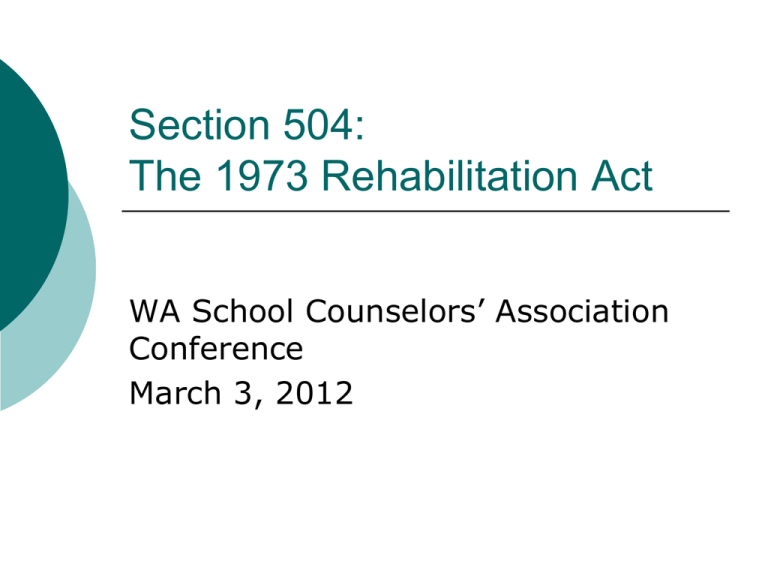
Section 504: The 1973 Rehabilitation Act WA School Counselors’ Association Conference March 3, 2012 Equal Opportunity Nothing is more unequal than the equal treatment of unequal people... Author Unknown Section 504 states... No otherwise qualified individual with a disability...Shall, solely by reason of his or her handicap, be excluded from the participation in, be denied the benefits of, or be subjected to discrimination under any program or activity receiving federal financial assistance. THIS IS THE LAW!!! Discrimination Discrimination is the exclusion from participation in, the denial of benefits of, any program or activity receiving or benefiting from federal financial assistance. Students may not be denied participation in or be denied benefit from services that are afforded non-disabled students. Equal Education Opportunities An appropriate education is a program designed to meet the individual educational needs of individuals with disabilities as adequately as the needs of nondisabled students are met Free Appropriate Public Education!!! Who are the “pure” Section 504 Students? Section 504 Students IDEA Not IDEA Eligible? Section 504 eligibility is not a consolation prize for students who do not qualify for special education. Perry Zirkel, Lehigh University Handicapped Persons (1) “Handicapped persons” means any person who (i) has a physical or mental impairment which substantially limits one or more major life activities, (ii) has a record of such an impairment, or (iii) is regarded as having such an impairment. OCR: Staff Memo, 1992, 19 IDELR 894 Major Life Activities are critical to eligibility The major life activity piece is often the wild card in the 504-eligibility process. MLA is probably the most misunderstood part of the eligibility rubric. These are basic functions that make us human. Focus of Determining Eligibility The basic elements that constitute a major life activity, AND Whether a substantial limitation is related to such an activity. What about LEARNING? Learning is the primary emphasis in schools, BUT... A student does not need to be substantially limited in the major life activity of learning to be eligible under Section 504: EXAMPLE: Physical or mental impairments may substantially limit major life activities other than learning that interfere with a student’s ability to access and benefit from the school’s programs and activities. This type of impairment would trigger 504 eligibility. Making Eligibility calls Ask yourself Does the disability prevent the student from getting what everyone else gets? If not, then there’s no Section 504 eligibility. Substantial Limitation Significantly restricted as to the condition, manner, or duration under which an individual can perform a particular major life activity as compared to the condition, manner, or duration under which the average person in the general population can perform the same major life activity. 29 CFR 1630.2(J)(2) Determining Substantial limitations Does an impairment substantially impact a student’s learning? Measuring learning success is a difficult task. What does it mean to “succeed” in regular education? (not entirely clear) Guideline: Students with learning disabilities who pass from grade to grade while functioning further and further below norms for their age are NOT succeeding in regular ed. No single formula or scale to measure substantial limitation The determination of substantial limitation must be made on a caseby-case basis with respect to each individual student. Substantial Limitation • • Changes as of January 2009: Lower Standard: reduce the depth of analysis related to the severity of the impairment limitation. Focus on discrimination (access to services) Are activities limited in Condition, Duration or Manner? Substantial Limitation Changes: An impairment that substantially limits one major life activity need not limit other major life activities in order to be considered a disability. Example: The ADA Amendment rejects the assumption that an individual who has performed well academically cannot be substantially limited in activities such as learning, reading, writing, thinking or speaking. Substantial Limitations Episodic or in Remission? • This is a disability if it would substantially limit a major life activity when active. • Example: Seizure disorder that is in remission. Questions for 504 Building teams to use to determine eligibility What is the nature and severity of the impairment? What is the duration, or expected duration, of the impairment? Does the student consistently need extended time to complete assignments? Does the student consistently need substantial changes made to the curriculum? Questions for 504 Building teams to use to determine eligibility Does the student consistently exhibit difficulties with planning and organization? Has the student shown a consistent downward slope in academic progress? Has the student shown a consistent pattern of negative behaviors? Major Life Activities Previous major life activities: • Caring for oneself • • • • • Performing manual tasks Seeing & hearing Speaking Breathing Learning and working Major Life Activities Changes as of January 2009: • Eating & Sleeping • Walking & Standing • Lifting & Bending • Reading • Concentrating • Thinking & Communicating Mitigating Measures • New Changes as of January 2009: Schools cannot consider the effect of mitigating measures when determining qualification. • Examples: medication, medical supplies, equipment, prosthetics, hearing aids, mobility devices, assistive technology, etc. So, faced with these changes, how should you proceed??? 1. Determine if the student has a qualifying impairment. Start there, and then move through the other aspects of the eligibility definition process. 2. Take time to learn more about the types of adaptations a student uses outside of the school environment. 3. Talk to the student and his parents about the types of adaptations he uses and for what reasons. The 504 Meeting Part I: Examine student data Medical or psychological reports Parent testimony Teacher feedback Test scores, attendance reports, grades, behavior reports, etc. Is a diagnosis of ADD/ADHD enough to trigger 504 eligibility? In a word, “No”. A medical diagnosis is only one source used in evaluating a student with an impairment or believed to have an impairment which substantially limits a major life activity. Other sources to consider: Aptitude and achievement tests Teacher recommendations Physical condition Social and cultural background Adaptive behavior Common ADD/ADHD Misconceptions Misconception: Staff members may blame a student’s lack of progress on being lazy. Misconception: A student must fail all of his classes to receive accommodations. Misconception: General education interventions supplant the need for accommodations. Misconception: The student takes medication, so he doesn’t need Discipline A handicapped student may not be suspended for more than ten days without a determination that misconduct is not caused by the disability The determination is made by the same people making the Section 504 placement decision District must conduct a re-evaluation Must take into account recent evaluation data that provides an understanding of the student’s current behavior. OCR: Long-term Suspension or Expulsion, 1988 Manifestation Determination Is the student accommodation plan appropriate? Is the current placement appropriate? Was the student accommodation plan implemented? Did the disability impair the student’s understanding of the consequences of the behavior? Did the impairment limit the student’s ability to control the behavior? Discipline Include parents in the manifestation determination. The 504 team shall modify the current educational placement when the misconduct is directly caused by the disability, if appropriate, an alternative educational placement. The principal may initiate normal disciplinary procedures when the misconduct is not directly caused by the disability. Substance Abuse Current drug users are excluded from the definition of handicapped under Section 504 and the ADA Current drug and alcohol users are subject to the same disciplinary action to the extent applied to non handicapped students for similar conduct. OCR: Staff Memo, 1991, 17 IDELR 609 References Material from this presentation used with permission from James F. McKethan, Ed.D. Who’s Eligible for Section 504? A Quick-Reference Guide for Proper Placement, LRP Publications, 2010. Questions? Becky Ballbach Everett Public Schools District School Counseling Program Specialist (425)385-6691 rballbach@everettsd.org
